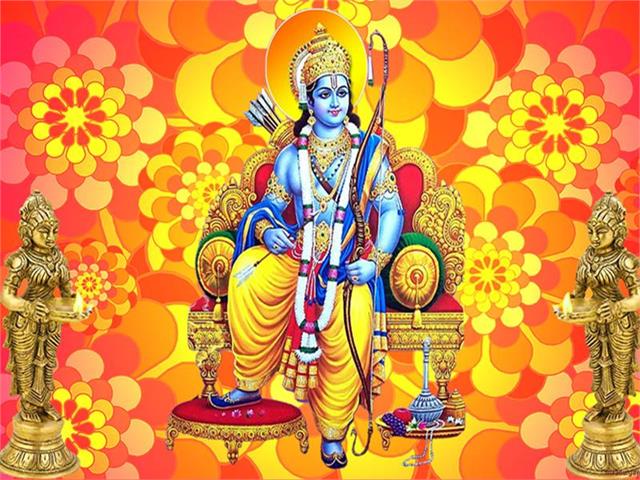|
Sri Rama & Sri Rama Rajya
The Rama is not only for chanting but the role model for modern youth. The team builder, the team leader, the dharma, one who exemplified various relationships, the incarnation of almighty, the hope, the soul of people of Bharat. Sri Rama can be simply described as a man who displays perfect moral as well as social behaviour. Sri Rama, in the words of Swami Vivekananda, is “the embodiment of truth, of morality, the ideal son, the ideal husband and above all, the ideal king”. He is a symbol of the victory of right over the evil. Lord Rama characterizes how a man should fulfil his moral commitments and should strictly follow his limits so that social order can be maintained. It is precisely due to this fact; he is known as “Marayada Puroshattam” or “The man of limits”. Dr Hariom Pawar, the famous poet from Bulandshahr, Uttar Pradesh wrote a popular poem. Its excerpts are as under: “…राम मिलेंगे मर्यादा से जीने में; राम मिलेंगे बजरंगी के सीने में; राम मिले हैं वचनबद्ध वनवासों में; राम मिले हैं केवट के विश्वासों में; राम मिले अनुसुइया की मानवता को; राम मिले सीता जैसी पावनता को; राम मिले ममता की माँ कौशल्या को; राम मिले हैं पत्थर बनी आहिल्या को; राम नहीं मिलते मंदिर के फेरों में; राम मिले शबरी के झूठे बेरों में…” “Ram would meet by living with dignity; Ram would meet in the heart of Sri Hanuman; Ram would meet in determined inhabitants of forests; Ram met in the beliefs of Kevat; Ram met Anusuiya's humanity; Ram met in Sita-like purity; Ram met to mother of love, Kaushalya; Ram met to stone-made Ahilya; Ram does not meet in visits to temples; Ram met in the partly eaten berries of Shabri” Ram Rajya have been the symbol of good governance, progress, prosperity, and peace - the ideal form of governance. A study of ancient scriptures tells us that during Rama's rule, there was no room for pain, poverty, disease, grief, or discrimination. He provided immediate justice and the poor were not marginalised. Truth and non-violence were the creed people followed, without coercion, and out of free moral responsibility and self-discipline. Ram's own behaviour carved that consciousness in the hearts of the subjects. According to the concept of Ram Rajya, the king ought to practice austerity, generosity, kindness, be just, welfare-oriented and capable of caring and planning for his subjects. Challenges faced by India today:
Selfishness in Relationship:
Discrimination: Sri Rama set an example to treat all equally.
Terrorism: These days different form of terrorism is on rise which is impacting social and national security. Terrorism during the time of Sri Rama was also prevalent. When Sri Rama was less than sixteen years old and not even completed the studies, rishi Vishvamitra demanded his help to kill the immensely strong rakshasas named Tadaka, Maricha and Subahu. They were harassing rishis by destroying their Yajnas. Raja Dasaratha, who was initially hesitant but later permitted Sri Rama and Sri Lakshamna to go along with rishi Vishvamitra to protect both rishis and their Yagnas. Sri Rama obeyed the directions of his father and proceeded to terrible forest along with his brother Sri Lakshamna and rishi Vishvamitra and slayed the rakshasas. Later, during fourteen years’ exile, Sri Rama killed many Rakshasas such as Viradha, khara, Dushana, Meghnath, Ravana etc. to protect the innocent citizens. Growing Population: In the olden times, people especially kings were generally holding more than one wife. Even the father of Sri Rama, Dasratha was having three wives. In those days, Sri Rama vowed to marry only once. Sri Rama married with Ma Sita and had great love for his wife. He resisted any temptation that could come in the way of his love for his wife. He taught the way of life which eliminated crime against women. When demoness Shurpanakha disguises as a woman to seduce Rama, then stalks and harasses Rama's wife Sita after Rama refuses her. After Ravana was killed Mandodari came to Sri Rama and said, she has found one quality in Sri Rama that even the shadow of a woman other than his wife should not touch Him. Ravana, on the other hand, was willing to sacrifice so many lives in his attempt at making another man's wife his. Therein lies the difference. That one quality of Sri Rama has led to His victory, says Mandodari. Erosion in value system: India is facing the menace of corruption, dishonesty, violence, and deceit. The incidents of rape are increasing, corruption is entrenched at all the levels and violence is becoming acceptable in our society. It is here where we need Sri Rama again with us to tell us that it is his character that we need to emulate today. Sri Rama established a sound judicial system which ensured that every person is happy under his rule all times. Sri Rama was a selfless king who thought of his people before thinking about himself. Tulsidas mentioned that in Ram Rajya, no one suffered at physically, spiritually and bodily. Everyone lived in harmony with affection towards each other while performing their own duties as described in the scriptures. All the four limbs of the Dharma – Truth, Purity, Compassion & Charity were fulfilled.
0 Comments
|
Archives
May 2024
Categories |

 RSS Feed
RSS Feed